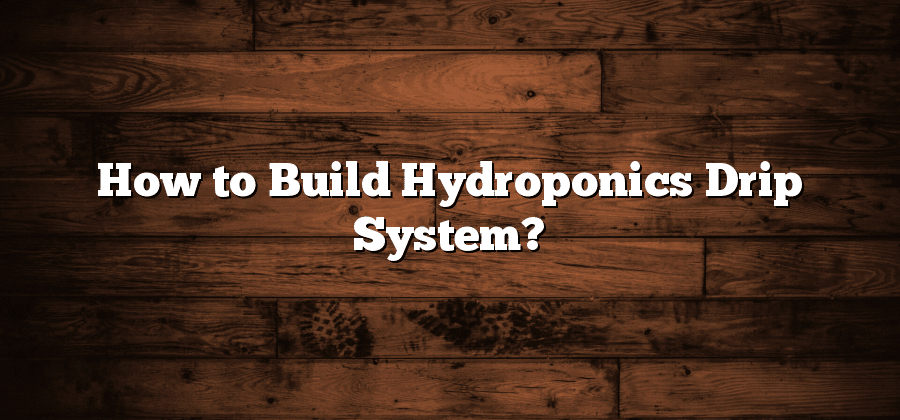Understanding Hydroponics Drip Systems: An Overview
Hydroponics drip systems are a popular and efficient method of growing plants without the use of soil. This hydroponic system is designed to provide a constant and controlled flow of nutrient-rich water to the plant roots, ensuring optimal growth and productivity. With a drip system, water and nutrients are delivered directly to the root zone, eliminating the need for the plants to search for nutrients in the surrounding soil.
One of the key benefits of a drip system is its ability to conserve water and nutrients. Unlike traditional soil-based farming, where a significant amount of water is lost through evaporation or runoff, drip systems minimize water wastage by delivering water directly to the plant roots. This targeted approach not only reduces water consumption but also prevents nutrient leaching, ensuring that the plants receive the right amount of essential elements for their growth. Additionally, drip systems allow for precise control over the amount and frequency of water and nutrients delivered, enabling growers to optimize plant nutrition and minimize resource wastage.
Selecting the Right Components for Your Drip System
When it comes to selecting the right components for your hydroponics drip system, it is important to choose quality materials that will promote efficient and effective plant growth. One of the first components to consider is the drip emitters. These small devices are responsible for delivering the nutrient-rich solution to your plants in a slow and controlled manner. It is crucial to invest in emitters that are reliable and durable, as they will play a vital role in the success of your hydroponics system.
In addition to drip emitters, tubing is another essential component that needs to be carefully selected. High-quality tubing will ensure that the nutrient solution is delivered to each plant evenly and consistently. Opt for tubing materials that are resistant to clogging and have good flexibility, as this will make installation and maintenance easier. It is also important to choose tubing with the appropriate diameter to match the flow rate of your system. By carefully selecting these key components, you can help ensure that your hydroponics drip system functions optimally and provides the necessary nutrients for your plants’ growth.
Designing Your Hydroponics Drip System Layout
When it comes to designing a hydroponics drip system layout, there are several key factors to consider. First and foremost, you must take into account the available space in your growing area. This will determine the size and scale of your drip system. Additionally, you need to think about the types of plants you will be growing and their specific needs. Different crops require different water and nutrient levels, so it’s important to plan accordingly.
Another crucial aspect of designing your hydroponics drip system layout is determining the placement of the components. You’ll need to strategically position the water supply, drip lines, and emitters to ensure proper water distribution to each plant. It’s important to note that gravity plays a vital role in a drip system, so you’ll need to position your system in a way that allows water to flow effortlessly from the water supply to the plants. Additionally, consider the accessibility of your system for maintenance and adjustment purposes.
By carefully considering the available space, plant requirements, and component placement, you can optimize your hydroponics drip system layout for maximum efficiency and yield. A well-designed layout will facilitate the effective delivery of water and nutrients to your plants, helping them thrive and produce the desired results.
Assembling the Drip System: Step-by-Step Guide
To assemble your drip system for hydroponics, start by gathering all the necessary components and tools. These will typically include a water reservoir, a submersible pump, a timer, a pressure regulator, drip emitters, tubing, connectors, and stakes to hold the tubing in place. Make sure to choose high-quality components that are compatible with each other and suitable for your specific hydroponic setup.
Once you have all the components, the first step is to connect the submersible pump to the water reservoir. Place the pump in the reservoir, making sure it is fully submerged. Connect the pump to a length of tubing that will run from the reservoir to the rest of the system. Secure the tubing in place with connectors or clips. From there, install the timer and pressure regulator in line with the tubing, ensuring they are properly connected. The timer will allow you to automate the watering schedule, while the pressure regulator helps maintain a consistent flow of water through the system.
Choosing the Ideal Growing Medium for Hydroponics
Finding the right growing medium is crucial for a successful hydroponics system. The growing medium serves as a support system for the plants, providing stability and ensuring roots have access to oxygen and water. There are several factors to consider when selecting the ideal growing medium for hydroponics.
Firstly, it’s important to choose a growing medium that has good water retention properties. This is important as hydroponics systems rely on a continuous supply of water and nutrients to the plants. Look for growing mediums that can hold moisture while still allowing for proper drainage to avoid water logging.
Secondly, consider the porosity of the growing medium. A highly porous medium will allow for better aeration and oxygen exchange for the roots. This is important for the overall health and development of the plants. Consider using growing mediums such as expanded clay pellets, coconut coir, perlite, or vermiculite, which are all known for their excellent porosity.
In conclusion






